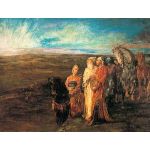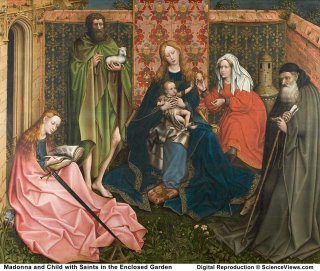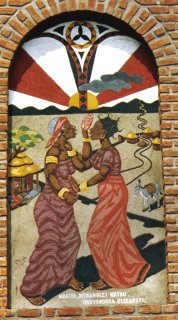Here are my reflections on Sunday's artpiece - info on Boucher from
here, and art reflections mine.
Mary and Elizabeth
Painted 1996
by Father Claude Boucher & Tambala Myponyani
Claude Boucher was born in Montreal, Canada in 1941. As a child he was became very interested in Africa spending many hours in a local African museum.
He inherited his mother’s artistic ability and from the age of four was drawing and doing work in pastels.
Later at school, his teachers recognised his ability and encouraged him in his art. As a young man, he worked with a variety of artistic techniques and exhibited his work.
In 1962 he felt called to become a priest, specifically to join the Society of the Missionaries of Africa, popularly known as the White Fathers.
When he went into seminary Claude was convinced that he should leave his artistic career behind. To be a priest and an artist at the same time
seemed to him a contradiction.
And at seminary he was encouraged to leave behind what the theology of the time called the “old Adam”… The old man, his old self…
Except when the church needed to be decorated for Christmas and other major feasts, Then they were quick to utilise his artistic talents!
Boucher was only allowed to paint at the request of his superiors, who also permitted him, in his quiet times, to paint meditative works, depicting his spiritual experiences
He was occasionally asked to produce some minor commissions for the community, and he produced a variety of artistic and theatrical works, including a pavilion at Montreal’s World Exhibition in 1967.
Despite his own earlier intentions and the mindset of his superiors at the seminary, when Claude Boucher was ordained priest in 1967, he cannot be said to have left behind the old man, the artist.
What he had begun, in fact, was to integrate the “old man” of culture with the “new man” of religion.
And this is an essential aspect in understanding his later work – both his missionary work and works of art including this one.
Claude Boucher went to Malawi in December 1967.
Soon after he arrived he started to create a series of slides later called “The Good News of Jesus Christ”.
In more than 2,000 photos Claude Boucher re-created biblical scenes featuring Malawians in the Malawian countryside.
He did this deliberately to demonstrate that Christ has become human not only in Israel but also in Malawi.
He said of this work,
“I asked myself how Malawians might be helped to recognise Jesus as their brother. For them it doesn’t matter very much whether Jesus has a white or black face. What is far more important
is whether his attitude and behavior are African, What are the paths on which he walks
and what are the landscapes he moves through?”
He said:
“I had a technicolor dream: the dream of letting the Gospel shine in the hues and tints of ordinary day-to-day life in Malawi.”
He began to discover other artists and craftspeople, and learned skills in traditional carving for himself.
In 1970 Claude Boucher met a young man named Tambala Myponyani who would become a very skilled painter.
Together Claude and Tambala decorated many churches in the years that followed. They became close friends, and work colleagues, both in art and administrating an Art and Craft centre, an art academy oriented towards the local culture.
In that academy many African artists were trained, as they reflected on what the Christian story meant to them within the context of their own culture, and how they could portray that
using a variety of artistic techniques.
We tend to understand artists as autonomous, with the art being the work of some-one.
African artists, on the other hand, are far more aware that every work of art owes a great deal to the community from which it comes.
And so this piece was produced. A collaborative work by a French Canadian Catholic Priest
and a Malawian lay person.
Mary and Elizabeth are both African, Malawian.
In Malawian countryside, with grass-thatched huts.
There is a tired-looking donkey
And an old man on his stoop, is that Zechariah?
A road leads down from the mountains.
An acacia tree shows green leaves
Mary has her hand on Elizabeth’s stomach,
feeling the kicks - the leaps - of Elizabeth’s baby
the baby who will be John the Baptist.
Elizabeth acknowledges heaven as she speaks her words of blessing to Mary
The coming of Mary was also a coming of Elizabeth’s Lord.
And Elizabeth’s baby recognised the Christ-baby within Mary.
Behind the horizon, a sun, (but not the same sun that casts the shadows)
Shows red and white rays.
White for purity, for Christmas?
Red for the cleansing blood
of the Saviour who is Christ the Lord?
Two black clouds hover
Are they threatening?
Or are they (in this African landscape) clouds of promise?
Promising rain to parched land
Promising spiritual refreshment for parched souls?
Like in last week’s piece, there is a curtain motif.
With the pattern at the centre of the sun splitting from heaven down, as Jesus Christ breaks into our world.
Questions I wondered about in relation to this piece…
How could an artist paint Mary and Elizabeth today
In Aotearoa New Zealand
In your neighbourhood?
Because they were everyday women, in everyday towns.
And as we think about the artists, particularly about Boucher,
What are our natural talents, our God-given talents that God would have us use for God’s glory?
What promise is dwelling within us this Advent?
And finally, where do we need
Where do you need
God to rain refreshment on parched land.



